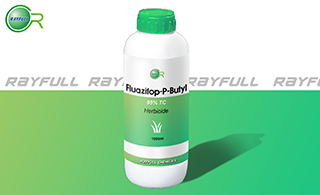FLUAZIFOP-P-BUTYL
  ҫ«ЯБ·ъәМІЭБй ҫ«ЯБ·ъәМІЭБй
Introduction: Fluazifop-P-Butyl is a post-emergence herbicide used to control grass weeds mainly in broad-leaved crops.
Common name: Fluazifop-P-Butyl
Another name: Fusilade S, Fusilade DX, Fusilade II, etc.
Chemical name: butyl (R)-2-{4-[5-(trifluoromethyl)-2-pyridyloxy]phenoxy}propionate
Empirical formula: C19H20F3NO4
Structural formula:

Mol. Weight: 383.36 g/mol
CAS No.: 79241-46-6
Specifications
Leading Fluazifop-P-Butyl supplier
Fluazifop-P-Butyl 90% TC
Fluazifop-P-Butyl 95% TC
Packing:
BULK PACKING
Liquid: 200L/Drum, 20L/Drum, 10L/Drum ect.
SMALL PACKING
Liquid: 5L/Drum, 1L/Bottle, 500ml/Bottle, 250ml/Bottle, 100ml/Bottle, 50ml/Bottle etc.
Customerized packing label
Fluazifop-P-Butyl FAO standard
Professional registration
HAZARDS IDENTIFICATION
Hazard statement(s)
H361d: Suspected of damaging the unborn child.
H410: Very toxic to aquatic life with long lasting effects.
Precautionary statement(s)
P201: Obtain special instructions before use.
P202: Do not handle until all safety precautions have been read and understood.
P273 Avoid release to the environment.
P281: Use personal protective equipment as required.
P308+P313: IF exposed or concerned: Get medical advice/attention.
P391 Collect spillage.
P405: Store locked up.
P501: Dispose of contents/container to ...
Supplemental Hazard Statements: none
MAMMALIAN TOXICOLOGY
Acute toxicity: 1) Acute oral LD50 for rat: 2451 a.i.mg/kg. 2) Acute dermal LD50 for rat: >2110 a.i.mg/kg. 3) Inhalation LC50 (4 h) for rat: >5.2 a.i. mg/L. 4) Mildly-irritating to skin (rabbits). 5) Non-irritating to eyes (rabbits). 6) Not a skin sensitizer (guinea pig). NOEL: (90 d) for rats is 0.75 mg/kg b.w. daily (10 ppm), mice is 1.4 mg/kg b.w. daily (10 ppm), dogs is 15.9 mg/kg b.w. daily (400 ppm).
ADI(JMPR): 0.004 mg/kg b.w./day[2016]
Classification:
Toxicity class WHO (a.i.): III (Slightly hazardous)
US EPA Classification (formulation): III (Caution - Slightly toxic)
EC Risk Classification: Reproduction risk category 3: R63; Xn - Harmful: R48/22, R43; N - Dangerous for the environment: R50, R53
ECOTOXICOLOGY
Effect on birds: low toxicity to birds, acute LD50 for Mallard ducks is >3960 a.i.mg/kg. Effect on fish: moderate toxicity to fish, acute 96 hour LC50 for Rainbow trout is >1.41 a.i.mg/L. Effect on aquatic invertebrates: moderate toxicity to aquatic invertebrates, acute 48 hour EC50 for Daphnia magna is >0.62 a.i.mg/L. Effect on algae: moderate toxicity to algae, acute 72 hour EC50 for Pseudokirchneriella subcapitata is >0.67 a.i.mg/L. Effect on honeybees: low toxicity to honeybees, contact acute 48 hour LD50 is >200 a.i.ҰМg/bee, oral acute 48 hour LD50 is >200 a.i.ҰМg/bee. Effect on earthworms: moderate toxicity to earthworms, acute 14 day LC50 for Eisenia foetida is >500 a.i.mg/kg.
ENVIRONMENTAL FATE
Fluazifop-p-butyl breaks down rapidly in moist soils. Its half- life in moist conditions is generally less than a week. The major degradation product of fluazifop-p-butyl will also break down fairly rapidly. Its half-life is around three weeks.
Fluazifop-p-butyl is actively taken up by plants and translocated throughout the plant. The compound accumulates in the actively growing regions of the plant (shoots, root rhizomes, stolons of grass) where it interferes with the plant cell's ability to produce energy. In plants, fluazifop-p-butyl is rapidly broken down in the presence of water to fluazifop-p.
Usage: The herbicidal enantiomer of fenoxaprop was reported by H. P. Huff et al. (Proc. Br. Crop Prot. Conf. - Weeds, 1989, 2, 717). Introduced by Hoechst AG (now Bayer CropScience). Manufacturers: Bayer CropScience; Sharda; Sundat; Tide. Fatty acid synthesis inhibition in grasses, by inhibition of acetyl CoA carboxylase (ACCase).
Application: Fenoxaprop-P-ethyl is a selective herbicide with contact and systemic action, absorbed principally by the leaves, with translocation both acropetally and basipetally to the roots or rhizomes.Post-emergence control of annual and perennial grass weeds in potatoes, beans, soya beans, beets, vegetables, peanuts, flax, oilseed rape, and cotton; and (when applied with the herbicide safener mefenpyr-diethyl) annual and perennial grass weeds and wild oats in wheat, rye, triticale and, depending on ratio, in some varieties of barley. Phytotoxicity Non-phytotoxic to broad-leaved crops.
| 






